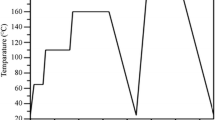Abstract
The tensile mechanical properties of hybrid composites fabricated from glass and carbon fibres in an epoxy matrix have been evaluated over a range of glass: carbon ratios and states of dispersion of the two phases. The failure strain of the carbon phase increased as the relative proportion of carbon fibre was decreased, and as the carbon fibre was more finely dispersed. This behaviour is commonly termed the “hybrid effect”, and failure strain enhancement of up to 50% has been measured. Only part of the effect may be attributed to internal compressive strains induced in the carbon phase by differential thermal contraction as the composite is cooled from its cure temperature. The laminae or ligaments of carbon fibre dispersed in the glass fibre phase show a multiple failure mode, and when the constitution is favourable catastrophic failure does not occur until a considerable number of ligament fractures have accumulated. Failure is thus progressive, and the material is effectively “tougher” than equivalent all-carbon fibre composites.
Similar content being viewed by others
References
J. Summerscales and D. Short, Composites 9 (1978) 157.
J. Aveston and A. Kelly, Phil Trans. Roy. Soc. A294 (1980) 519.
Idem, J. Mater. Sci. 8 (1973) 352.
T. Hayashi et al., Fukugo Zairyo (Composite Mater.) 2 (1975) 18.
L. N. Phillips, Composites 7 (1976) 7.
Idem, Proceedings of the International Conference on Composite Materials, Toronto, 1978 (AIME, New York, 1978).
A. R. Bunsell and B. Harris, Composites 5 (1974) 157.
J. Aveston and J. M. Sillwood, J. Mater. Sci. 11 (1976) 1877.
G. Marom, S. Fischer, F. R. Tuler and H. D. Wagner, ibid. 13 (1978) 1419.
C. Zweben, ibid 12 (1977) 1325.
H. E. Edwards, N. J. Parrat and K. D. Potter, Proceedings of the International Conference on Composite Materials, Toronto, 1978 (AIME, New York, 1978).
P. W. Manders, PdD thesis, University of Surrey, 1979.
P. W. Manders and S. M. Bishop, Investigation of Fracture in Hybrid Composites using a Laser Moire Technique, Royal Aircraft Establishment, Technical Memo. MAT 333,1980.
P. W. Manders and M. G. Bader, J. Mater. Sci. 16 (1981) 2246.
Author information
Authors and Affiliations
Rights and permissions
About this article
Cite this article
Manders, P.W., Bader, M.G. The strength of hybrid glass/carbon fibre composites. J Mater Sci 16, 2233–2245 (1981). https://doi.org/10.1007/BF00542386
Received:
Accepted:
Issue Date:
DOI: https://doi.org/10.1007/BF00542386




